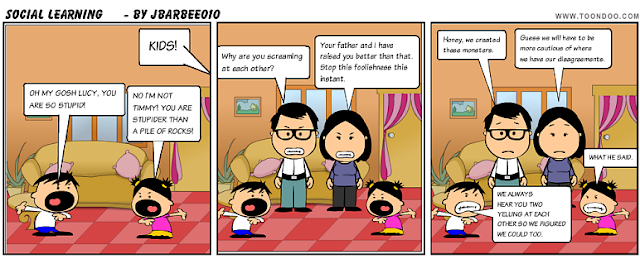MIGRAIN: Audience theory 2
1) Social learning theory has been criticised for simplifying the causes of violence in society. Do you think the media is responsible for anti-social behaviour and violence?
I think that the media is responsible for anti-social behaviour and violence to a small extent. As the social learning theory believes, when young children or teenagers watch violent content or play violent video games this may cause them to become violent themselves because they begin to believe that this is a natural part of life. They are desensitised from the thought that violent behaviour is wrong. This also may cause them to become anti-social as they would rather spend their time on their phones or playing games rather than go and interact with other people. However, I believe that it is not this simple. This effect may be true for certain individuals but not for the majority. We could argue that the media makes people more socially interactive because they want to play video games with their friends or show their friends a certain video. Furthermore, we could argue that violent video games are a way for people to take out the anger and stress in their everyday lives. By doing this, they are less likely to go commit violent crimes in real life.
2) How is social learning theory relevant in the digital age? Are young people now learning behaviour from social media and the internet? Give examples.
The social learning theory can be applied to the fact that people in the digital age are now exposed to more content. They can access anything anytime they want whether it be on phones, laptops or tablets and this may lead them to copy what they see. One example is the TV series '13 reasons why'. This show follows the fictional story of a teenage girl named Hannah Baker (Katherine Langford) who leaves behind 13 mysterious audio recordings on cassette tapes after killing herself. She addresses each recording to a person who she says played a role in her tragic decision to end her own life. Essentially this TV show idealised suicide and it led to many mental health experts to become worried about the effects it would have on teenagers who had watched the show. The social learning theory would believe that teenagers watching this show would lead to an increase in suicide.
3) Research five examples of moral panic from the last 50 years. To what extent was the media responsible for these moral panics? Was the concern in society justified? How have things changed as a result of these moral panics?
I) Ebola
In 2014, people were worried about the intentional transmission of the deadly Ebola virus from the continent of Africa to unsuspecting western countries. This moral panic is understandable as nearly 12,000 victims and over 4,000 dead people in Africa. The media played a large role in this as news of the Ebola virus was spread everywhere, even on social media apps like Instagram. However, the western response to Ebola in Africa has carried an unfortunate strain of racism, xenophobia, and centuries old panics about "folk devils." Fortunately, the virus has been cured since.
II) The Knockout Game
This is a term used for when Gangs of youths, usually described as African-American men, run up to strangers, usually described as white people, and punch them as hard as possible. These attacks are then filmed and uploaded to YouTube. This is probably the main factor that contributed to this arising as a moral panic. However, there is no real reason for this to be a big threat as it is actually not that bad. Statistics bear out that the vast majority of violent acts take place by two people who know each other, and black-on-white crime is actually rare.
III) Poisoned Halloween Candy
The moral panic over deadly treats started in 1974 when a young boy died after ingesting cyanide-laced Pixie Stix he got while trick-or-treating. People believed that unsuspecting children are at great risk from horrible neighbours putting poison in the candy they hand out for Halloween. They might also be putting razor blades in apples. However, a thorough investigation later implicated the boy's father, who had taken out large life insurance policies on his children, and attempted to throw off the trail by poisoning several children. But the man was caught and executed for his horrific crime. Since then, not a single case of laced candy has ever been uncovered.
IV) 3D Printed Guns
Ever since 3D printing became possible, some people believe that criminals will use this advanced 3D printing technology to make guns out of thin air and commit all manner of crimes. Children will do the same, leading to horrific accidents. The media definitely has a link to this moral panic. There have been many media platforms warning people about this danger (click here for example) and we do not know what to expect in the future and whether this will become a threat to our lives.
V) Terrorism
The most recent moral panic and the one that is still in society today is terrorism. People are becoming increasingly afraid of this dilemma and that is mostly the media's fault. Almost everyday we hear about a new terrorist attack and it just makes the moral panic worse. It has gotten to a point where simple crimes to do with quarrel are being labelled as terrorism. What people don't understand is that statistics show that terrorist attacks are not as common as we believe them to be.
References- https://www.ranker.com/list/moral-panic-examples/mike-rothschild
4) Read this introduction to an academic paper on technopanics. What examples are given of technopanics that create fear in society?
The examples of technopanics that create fear in society that are given in this paper are- technology policy debates, cyberspace, etc.
5) How does the author suggest that technopanics should be addressed - rather than through government regulation?
The author suggests that technopanics should be addressed through ongoing societal learning, experimentation, resiliency, and coping strategies rather than by regulation.
6) Do you think the internet should be regulated? Should the government try and control what we can access online?
Personally, I think that the internet shouldn't be regulated. It is up to the individual to watch or do whatever they want on the internet as this is their right. Most people are responsible enough to stay safe online. The actions of some shouldn't lead everyone else to be punished as well. However, I believe that parents should regulate their children's activity on the internet until they are old enough to be responsible on their own (about 10 years old)
7) Apply Gerbner's cultivation theory to new and digital media. Is the internet creating a fearful population? Are we becoming desensitised to online threats, trolling and abuse?
Gerbner's cultivation theory can be applied to digital media to some extent. We may be becoming desensitised to violence but not to online threats, trolling and abuse. When something like that happens, we know that we shouldn't accept it and we report it. Schools in the UK also teach children how to handle cyber bullying and what to do when we are faced with a tough situation.
8) Is heavy internet use something we should be worried about in society? How would you define 'heavy internet use'?
I would define heavy internet use as spending too much time on the internet (more than 10 hours) and not being able to live normally. For example, a person's use of heavy internet will lead to them becoming anti social and maybe they will even stop eating. I think we should definitely become worried about this if it becomes abundant in our society because this could effect the future drastically.



Comments
Post a Comment